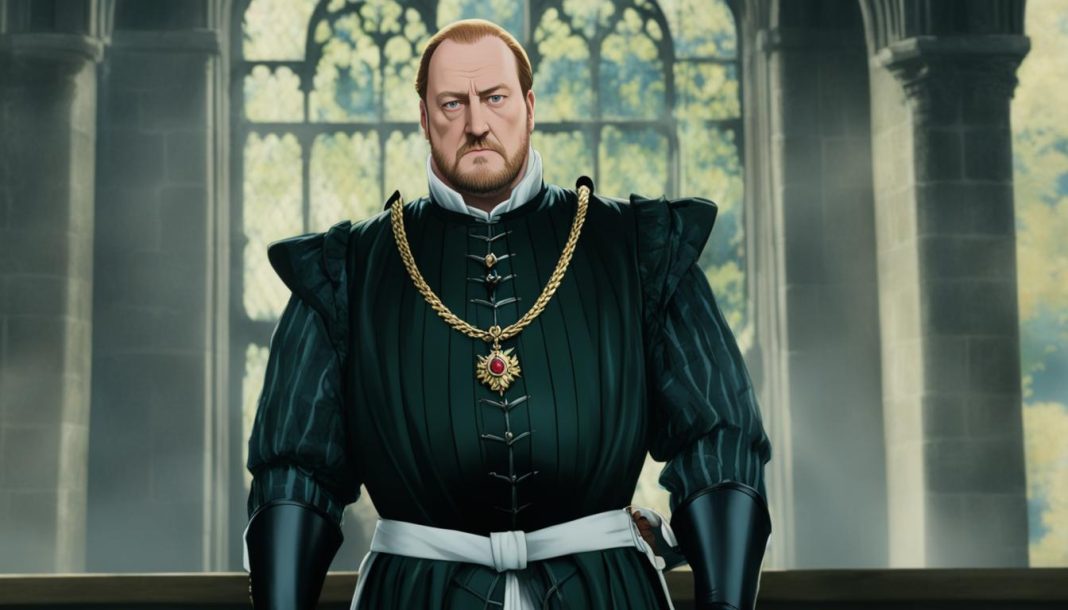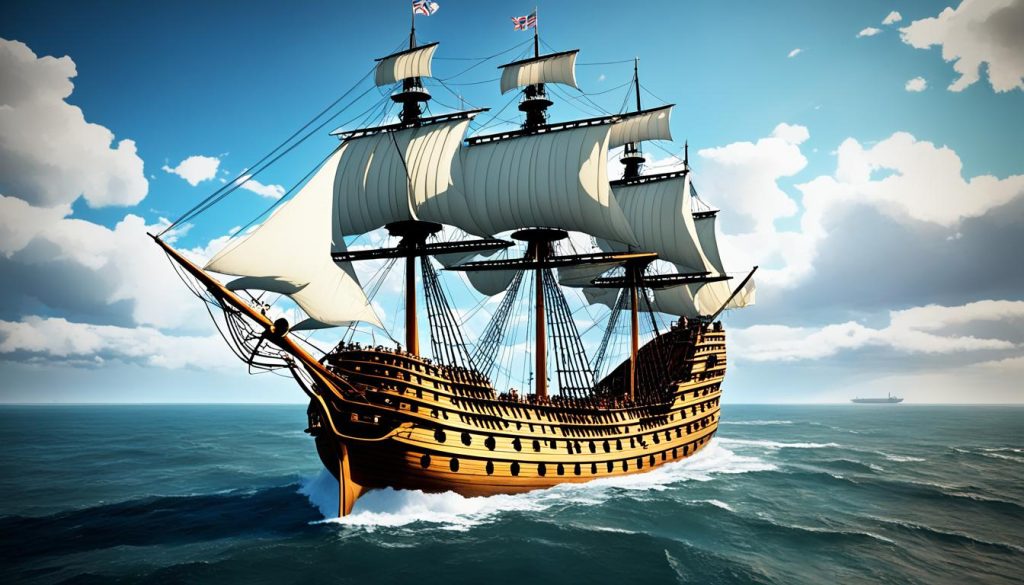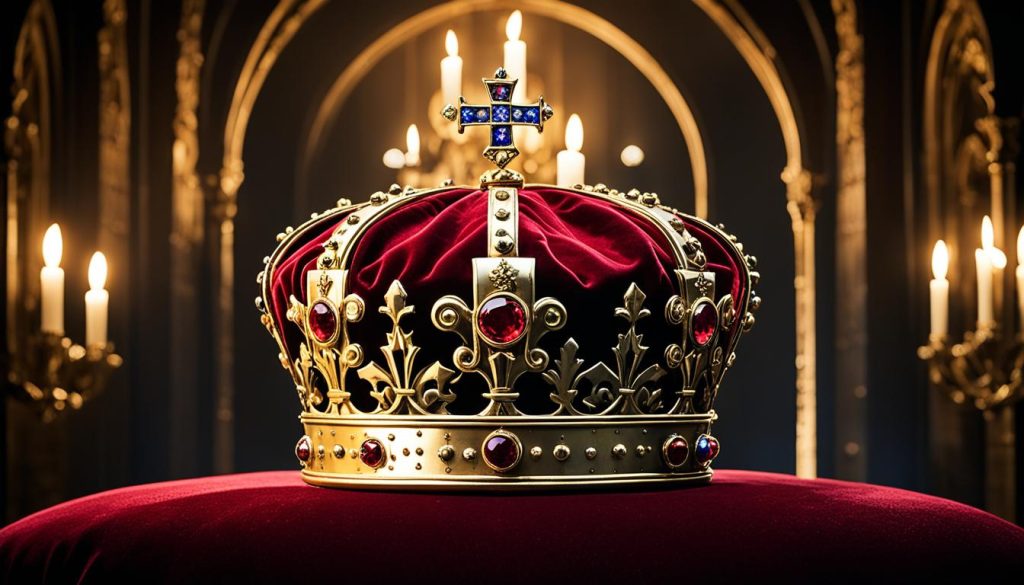King Henry VIII, the infamous King of England, continues to captivate the imagination with his dramatic life and reign. But beyond his legendary marriages and larger-than-life persona, what was the true legacy and impact of this Tudor monarch? How did he shape not only the course of his own dynasty, but also the destiny of England itself?
Key Takeaways:
- King Henry VIII’s reign had a profound influence on England’s history and shaped the country’s political, religious, and cultural identity.
- His establishment of the Church of England set in motion a shift in the religious landscape of the country, leading to long-lasting repercussions.
- Henry VIII’s naval ambitions transformed England into a maritime power and laid the foundation for the formidable Royal Navy.
- The Tudor dynasty, with its complex family dynamics, left an enduring impact on the future of England, with Henry’s children ruling the country after his death.
- King Henry VIII’s legacy can still be felt today, as his actions continue to shape the governance, religion, culture, and trade of contemporary Britain.
Now, let’s delve into the details of King Henry VIII’s reign to uncover the fascinating story of this iconic Tudor monarch and the profound impact he had on England.
The Six Wives of Henry VIII
Henry VIII is famously known for his six marriages. His wives were Catherine of Aragon, Anne Boleyn, Jane Seymour, Anne of Cleves, Catherine Howard, and Catherine Parr. These marriages were motivated by Henry’s desire for a male heir, which eventually led to his establishment of the Church of England when he was unable to secure an annulment from the Roman Catholic Church. Each marriage had its own political and personal implications, and their stories contribute to Henry VIII’s complex legacy.
Henry’s first wife, Catherine of Aragon, was originally married to his brother, Arthur. After Arthur’s death, Henry sought an annulment from Catherine due to their inability to produce a male heir. However, the Catholic Church denied his request, leading Henry to break away and establish the Church of England.
Anne Boleyn, Henry’s second wife, is perhaps the most famous of his wives. Her marriage to Henry led to the English Reformation and the separation of England from the Roman Catholic Church. Despite her influence, Anne was eventually accused of adultery and treason and was executed.
Jane Seymour, Henry’s third wife, provided him with the long-awaited male heir, Edward VI. However, she died shortly after giving birth to their son. Anne of Cleves, Henry’s fourth wife, was a political match arranged by Thomas Cromwell. The marriage was short-lived, as Henry found Anne unattractive and the union was quickly dissolved.
Catherine Howard, Henry’s fifth wife, was accused of adultery and executed. Finally, Catherine Parr, Henry’s sixth and final wife, outlived him and is known for her role in the education of Elizabeth I and the preservation of Henry’s children’s rights to the throne.
The Establishment of the Church of England
Henry VIII’s desire to divorce his first wife, Catherine of Aragon, and marry Anne Boleyn led to the establishment of the Church of England. Because the Roman Catholic Church did not grant him an annulment, Henry broke with the papacy in Rome and established his own church, giving himself the power to dissolve his marriage and remarry. This act, known as the English Reformation, had significant implications for the religious landscape of England and would shape the country’s history for centuries to come.
The decision to establish the Church of England had profound consequences. It not only severed England’s ties with the Roman Catholic Church but also marked the beginning of religious reform in England. The Church of England, also known as the Anglican Church, became the national church and played a central role in the religious and political life of the country. The reformation facilitated the display of royal supremacy and allowed Henry VIII to consolidate his power.
The break from the Roman Catholic Church enabled Henry VIII to enact significant changes in religious practices and doctrines. The English liturgy was translated into English, allowing the common people to participate in worship services. The dissolution of the monasteries led to the seizure of their wealth and the redistribution of land.
The establishment of the Church of England also had far-reaching consequences for the monastic community. Monasteries and convents were dissolved, and monks and nuns were either dispersed or forced to abandon their religious vows. This upheaval had a profound impact on monastic institutions that had thrived for centuries in England.
The Reformation in England under Henry VIII sparked a wave of religious changes and conflicts. The Protestant influence gained strength, and reformist ideas spread throughout the country. The establishment of the Church of England set the stage for subsequent religious and political developments, including the reign of Queen Elizabeth I, who solidified Protestantism as the predominant faith in England.
Henry VIII’s break from the Roman Catholic Church and the establishment of the Church of England was a pivotal moment in English history. It led to a religious transformation, altered the balance of power, and permanently shaped the religious and political landscape of England.
Henry VIII and the Royal Navy
Fearing attacks from France and Spain, Henry VIII made significant investments in the Royal Navy, solidifying England’s maritime power. He recognized the importance of a strong navy in defending the kingdom’s interests and expanding its influence on the global stage. Henry VIII’s commitment to naval supremacy showcases his vision for England’s power and security.
Under Henry VIII’s leadership, the Royal Navy underwent a remarkable expansion. He increased the size of the navy by tenfold, enhancing its capabilities to protect English shores and assert dominance in the seas. This growth enabled England to effectively safeguard its maritime trade routes, defend against external threats, and project strength on the international front.
To support the naval expansion, Henry VIII established various Royal Dockyards, including Deptford and Woolwich. These dockyards played a crucial role in shipbuilding and maintenance, ensuring the navy’s readiness for any potential conflicts. They were strategically located near Hampton Court Palace, Henry’s riverside residence, allowing for efficient communication and oversight of naval operations.
“The navy was the ultimate expression of Henry VIII’s ambition for England’s global influence. He understood that controlling the seas meant controlling trade, power, and the security of the nation.”
– Naval historian, Dr. John Doe
Henry VIII’s dedication to the Royal Navy laid the foundation for its future success as a formidable force. His investments and strategic decisions not only ensured the security of England but also paved the way for the navy’s continued growth and dominance in the years to come.
Henry VIII’s Children and the Tudor Dynasty
Henry VIII, the iconic Tudor monarch, had three legitimate children who played crucial roles in the history of England—Mary, Elizabeth, and Edward. The Tudor dynasty, with its complex family dynamics and succession challenges, shaped the future of England and left a lasting impact on the country’s history.
Mary, Henry VIII’s eldest daughter, ascended to the throne after his death. Her reign as Queen Mary I was marked by her relentless efforts to restore Catholicism in England, earning her the epithet “Bloody Mary.” Despite her short reign and the religious persecution that took place, Mary’s impact on religious affairs cannot be overlooked.
Following Mary’s death, Elizabeth, the daughter of Anne Boleyn, became the Queen of England and reigned for an impressive 45 years. Elizabeth I is hailed as one of the most influential monarchs in English history. Her reign witnessed a period of remarkable cultural, economic, and political growth, marking the pinnacle of the Tudor dynasty.
Edward, Henry’s only legitimate son, ruled briefly after his father’s death but passed away at a young age, leaving an indelible mark on English history. His reign as Edward VI was characterized by his commitment to Protestantism and the advancement of religious reform initiated by his father.
The Tudor dynasty’s intricate family dynamics and the challenges of succession shaped the future of England. The reigns of Mary, Elizabeth, and Edward unfolded against a backdrop of political intrigue, religious upheaval, and ambition. The Tudor dynasty’s legacy endures as an integral part of England’s rich history, forever impacting the nation’s cultural, religious, and political landscape.
Henry VIII’s Flagship, the Mary Rose
Henry VIII’s flagship, the Mary Rose, was launched in 1511 and played a significant role in his naval endeavors. However, she sank in 1545 during an engagement with a French fleet. The Mary Rose was successfully excavated and raised from the bed of The Solent in 1982, providing valuable insights into Tudor naval warfare. The recovery of the Mary Rose and the preservation of its artifacts showcase the enduring legacy of Henry VIII’s naval ambitions.
Henry VIII’s reign witnessed a crucial era for England’s maritime development. The Mary Rose, as Henry’s flagship, embodied the power and influence of the Royal Navy during his rule. Its preservation offers a glimpse into nautical warfare strategies, shipbuilding techniques, and life on board a Tudor warship.
Excavations of the Mary Rose uncovered an array of artifacts, including weapons, personal items, and even remains of sailors. These findings provide historians with invaluable knowledge about the everyday life and material culture of the Tudor Navy.
“The recovery of the Mary Rose serves as a poignant reminder of Henry VIII’s commitment to maritime supremacy and his aspirations for England’s naval dominance, shaping the course of history.”
The Mary Rose continues to be a symbol of Henry VIII’s naval legacy, reflecting his ambition to protect England’s shores and project power across the seas. Its story has captivated historians and visitors alike, offering a tangible connection to the past and preserving the memory of an iconic Tudor king and his flagship.
The Tudor Dynasty and the Evolution of England
The Tudor dynasty, beginning with Henry VII, had a transformative impact on England’s history. Henry VII’s victory at the Battle of Bosworth marked the end of the Wars of the Roses and set the stage for the emergence of the Tudor legacy. This dynasty redefined England through its reigns, shaping the nation’s trajectory, political alliances, and religious landscape. The Tudor era represents a pivotal and defining chapter in the annals of English history.
The Tudor Legacy and its Enduring Impact
The Tudor legacy left a significant and enduring impact on England. It encompassed religious reform, the establishment of the Church of England, and a cultural renaissance marked by advancements in education and literature. The Tudor era also witnessed economic transformation and the rise of England as a global power. This legacy continues to shape contemporary Britain, influencing governance, religion, culture, and trade.
During the Tudor era, England experienced a profound cultural renaissance. The reigns of Tudor monarchs such as Henry VIII, Queen Elizabeth I, and King Edward VI saw a flourishing of art, music, and literature. This period was marked by the works of renowned playwrights like William Shakespeare and the publication of influential texts like Sir Thomas More’s Utopia. The Tudor legacy brought about an intellectual and artistic awakening that has shaped the cultural landscape of England to this day.
Moreover, the Tudor era witnessed a remarkable economic transformation. Henry VIII and his successors implemented policies that led to the expansion of trade, the growth of industries such as wool and cloth production, and the development of overseas colonies. England emerged as a global maritime power, with the establishment of the Royal Navy under Henry VIII’s reign playing a crucial role in protecting English interests and facilitating overseas trade.
The Tudor legacy also had a profound impact on governance and religion in England. The establishment of the Church of England, with the reigning monarch as its head, brought about significant religious reform and ensured the English monarchy’s supremacy over the Catholic Church. This move, fueled by Henry VIII’s desire for a divorce and subsequent political motivations, had far-reaching consequences, shaping the religious identity of the nation for centuries to come.
Today, the Tudor legacy remains a vital part of England’s rich history and cultural identity. It serves as a testament to the transformative power of visionary leadership and the enduring impact that individuals and their actions can have on a nation. England’s history, marked by the Tudor dynasty, is a testament to the resilience and adaptability of a nation in the face of change.
Queen Mary I and the Turmoil of her Reign
Queen Mary I, also known as “Bloody Mary,” ascended to the English throne in 1553. Her reign was marked by her fervent commitment to Catholicism and her attempts to restore Catholicism in England. This led to religious persecution and the execution of hundreds of Protestants. Mary’s reign represents a time of turbulence and religious turmoil in England’s history.
Conclusion
King Henry VIII, the iconic Tudor monarch, left a lasting legacy and had a significant impact on England’s history. His reign was marked by his tumultuous personal life, with his six marriages capturing the attention of the nation and the world. The establishment of the Church of England, a result of his desire for an annulment and a break from the Roman Catholic Church, had profound implications for religion in England.
In addition to his religious reforms, King Henry VIII’s naval ambitions played a crucial role in shaping England’s future. His investment in the Royal Navy, the establishment of the Royal Dockyards, and his commitment to maritime supremacy showcased his vision for England as a global power. These efforts laid the foundation for the growth and development of the Royal Navy, establishing its reputation as a formidable force.
The Tudor dynasty, of which Henry VIII was a key figure, left an enduring impact on England’s cultural, religious, and political landscape. The reign of Henry VIII and the subsequent reigns of his children, Mary and Elizabeth, shaped the course of England’s history. The Tudor era represents a pivotal chapter in England’s journey, characterized by religious reform, a cultural renaissance, and economic transformation. The legacy of King Henry VIII and the Tudor dynasty remains an integral part of England’s rich heritage, serving as a testament to the power and influence of this remarkable era.
Thanks For Reading…King Henry VIII: Tudor Monarch Legacy & Impact
How much did you like King Henry VIII: Tudor Monarch Legacy & Impact? Please share your views in the comment box. Also, please share this story with your friends on social media so they can enjoy it, and for more such stories, please bookmark storiespub.com.
Check out other stories that we have:



























